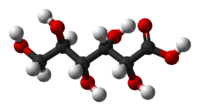
Photo from wikipedia
Abstract Magnesium oxychloride cement (MOC) has the advantages of low-carbon emission, reducing the magnesium chloride waste, and lack of humid curing. However, the MOC has not been widely utilized yet… Click to show full abstract
Abstract Magnesium oxychloride cement (MOC) has the advantages of low-carbon emission, reducing the magnesium chloride waste, and lack of humid curing. However, the MOC has not been widely utilized yet due to the poor water resistance and the short setting time at high ambient temperatures. Herein, a simple and low-cost approach was developed through incorporating D-gluconic acid sodium salt into the MOC. After adding 1.4 wt% D-gluconic acid sodium salt, the initial and final setting time were extended to 257 min and 421 min, respectively, compared to that of unmodified MOC (92 min and 192 min). Based on the X-ray photoelectron spectroscopy (XPS) analysis, the rod-like phase 5 (5 Mg(OH)2·MgCl2·8H2O) in the MOC was converted into the gel-like phase 5 through the chelation between D-gluconic acid sodium salt and phase 5. The gel-like structures were evidently observed in the MOC pores (especially after immersing in water), and they efficiently hinder the moisture penetrating into internal structure of the MOC. Subsequently, the softening coefficient was enhanced from 0.38 to 0.91 when the D-gluconic acid sodium salt content was increased from 0% to 1.4%. In comparison to the unmodified MOC, 0.6 wt% of D-gluconic acid sodium salt could enhance the compressive strength by 24.6% after curing for 7 days. When the D-gluconic acid sodium salt content increased to over 0.6%, the compressive strength decreased. Meanwhile, the analysis of phase components proved that the phase 5 content of the modified MOC specimens remained unchanged or even increased after immersing into the water, establishing protection of the gel-like structure on the phase 5.
Journal Title: Construction and Building Materials
Year Published: 2021
Link to full text (if available)
Share on Social Media: Sign Up to like & get
recommendations!